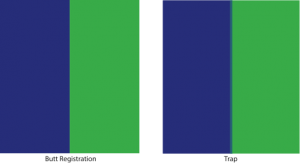Butt Registration, Choke, Spread and Trap
I have been asked several times lately about how to set-up artwork to register on the press more quickly. Usually the question of using butt registration vs trap comes into play. As an artist and a printer how the print looks determines what I use. There are several causes that effect how quick one can set-up a print job.
Here is a definition of terms.
Butt Registration: The alignment of artwork in which the registration of one color “butts” up against another color without any gap in between.
Choke: To reduce the thickness of the outer edge of an image so the print on top overlaps slightly covering the underbase edges.
Spread: In screen printing, adding a slight outline to an image for the purpose of compensating for printing press misregistration.
Trap: An outline placed around a 2 or more fill colors to compensate for misregistration.
As a printer you should make sure your press is maintained and the registration is tight. That also goes for the screens you are using. Always use tight screens. Otherwise there is little you can do to maintain registration of your print. Nothing worse that chasing the image around your t-shirt.
For my artwork I use butt registration. I do not like to see the colors overlap of the trap or spread method. I do however use a slight choke on my underbase to assure I don’t see it around the edge of my designs. I use a .375 pt choke because I don’t want to see a different color edge where the underbase is not printed.
What will save the most time setting up is how your shoot your screens. It is well worth the money to purchase a registration system that starts in the screen room and continues on the press. If you line up your artwork on the screens to print in a certain area that coordinates with how it will be set up on the press, you taking most of the time adjusting it on press out of the equation. Also using targets on the artwork will help you line up your print.
Another reason not to use the trap method is when your ink opacity is transparent or your artwork has halftones in it. If you use ink with low opacity the trap will create another color which may not be desirable. And it would be impractical to put a trap around the halftones.
My advice is maintain your equipment, use the best tools, develop processes for consistency and your prints will set-up nicely and look great too.
Until next month.
Cora Kromer
cora@qdigitizing.com
